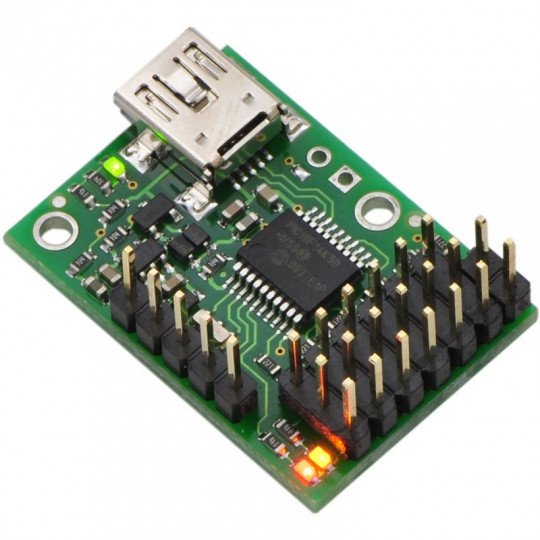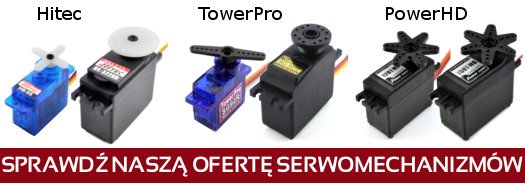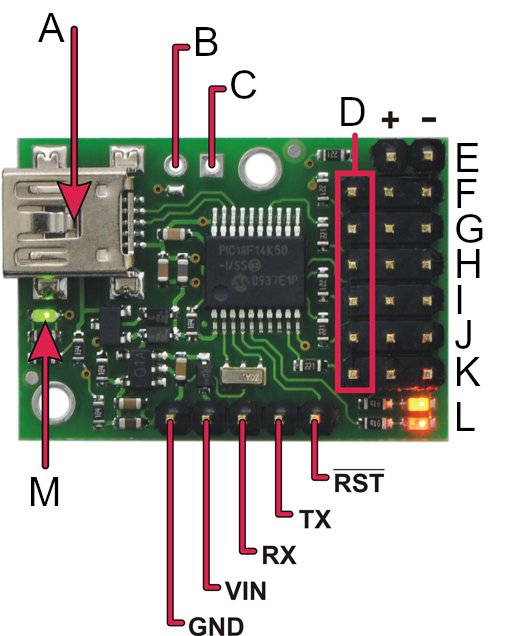Specification:
- Power supply: 5 V-16 V
- Current consumption: 30 mA*
- Number of channels: 6
- Speed of transmission: 300-200000 bps**
- Control methods:
- USB - included program for PC
- Serial interface (UART) - for example, communication with the microcontroller
- scripts saved in the memory of the controller
- Dimensions: 21.5 x 30.5 mm
|
The product is compatible with Arduino The manufacturer providesa library in GitHubfor Arduino users. |
Video
The film made by Pololu, introduces the possibilities of the product.
Description
The Maestro series are the universal controllers of servos which are also able to interpret the digital and analogsignals. Thanks to the different control options, a wide range of supply voltages, as well as the simple usage, Maestro has proven itself in many projects that use servos. Depending on the number of used servos, the user can choose a suitable option. Available are 6,12,18and24-channel modules.
|
|
||||
| Number of channels: | 6 | 12 | 18 | 24 |
| The number ofanalog inputs: | 6 | 12 | 12 | 12 |
| The number ofdigital inputs: | 0 | 0 | 6 | 12 |
| Width[mm]: | 21,6 | 27,9 | 27,9 | 27,9 |
| Length[mm]: | 30,5 | 36,1 | 45,7 | 58,4 |
| Weight[g]: | 3,0 | 4,2 | 4,9 | 6,0 |
| Pulse frequency: | 33-100 Hz | 1-333 Hz | 1-333 Hz | 1-333 Hz |
| The range of pulses: | 64-3280 μs | 64-4080 μs | 64-4080 μs | 64-4080 μs |
| The size of the script: | 1 KB | 8 KB | 8 KB | 8 KB |
The usage of the driver
The user can adjust the controller to the requirements of his/her project,choosing one of three different communication interfaces:
USB computer app -device connects to the computer usingthe mini USB cable. For the operation of the controller is an intuitive program that allows, i.a.:
- managing of the horn
- determination of the rotation speedof the servo
- reading the data from analog and digital inputs
- setting the logical values on the outputs of the I/O
In order to use the option of control via USB, just download the program to your disk (version:Windows,Linux), launch it and connect controller to any USB port on the computer.
Serial interface (UART) - the interface allows you to connect the Maestro with the central unit which can be any microcontroller or commissioning set, for example,Arduino,STM32DiscoveryorRasbperry Pi. Handling of the servos is done by sending special charactercommands. Examples with description can be found inthe manual.
The script- by selecting this option, the user can create and store in memory of the Maestro, the selected sequence of events, for example, the dependence of the position of servo from the voltage level on the analog input, to which connected is any analog sensor, e.g.,gyroscope,accelerometerorrangefinder. Description of scripting language together with examples of its usage, you canfind inthe instructions.
The computer app allows you to control the position and speed ofservos, to read and write status of I/O viaUSB cable.
Leads
Leads are the popular goldpin strips (2.54 mm pitch) suited for standard connectors of servosandconnecting cables.
On the board are:
- the miniUSB connector designed to connect the system to PC
- leads of the power rail 5V to power other systems
- connectors for attaching the power supply for theservos(+ and -)
- connectors forservos, leads, leads labeled as signal can also be used as analog inputs and digital inputs/outputs operating with voltages of 5 V
- status LEDs
- power connector of the logic systems (useful, if the driver is not permanently connected to the USB port)
- connectors of the serial communication interface UART (RX, TX)
Examples of usage
- projects using many servos,for example, the manipulator
- stepping robots, for example,Hexapods
- management of the servos using computer (USB cable)
- using channels as digital outputs with general purpose
- the use of channels of analog inputs, for example, to read information fromsensors(e.g.,Sharp 10-80cm) directly on PC
- in versions 12, 18 and 24, one of channels can operate as a PWM output, thus, it is possible to supportdriver of engines(for example,TB6612FNG)
Useful links |























































































































































































































































































































































 Micro
Micro
























